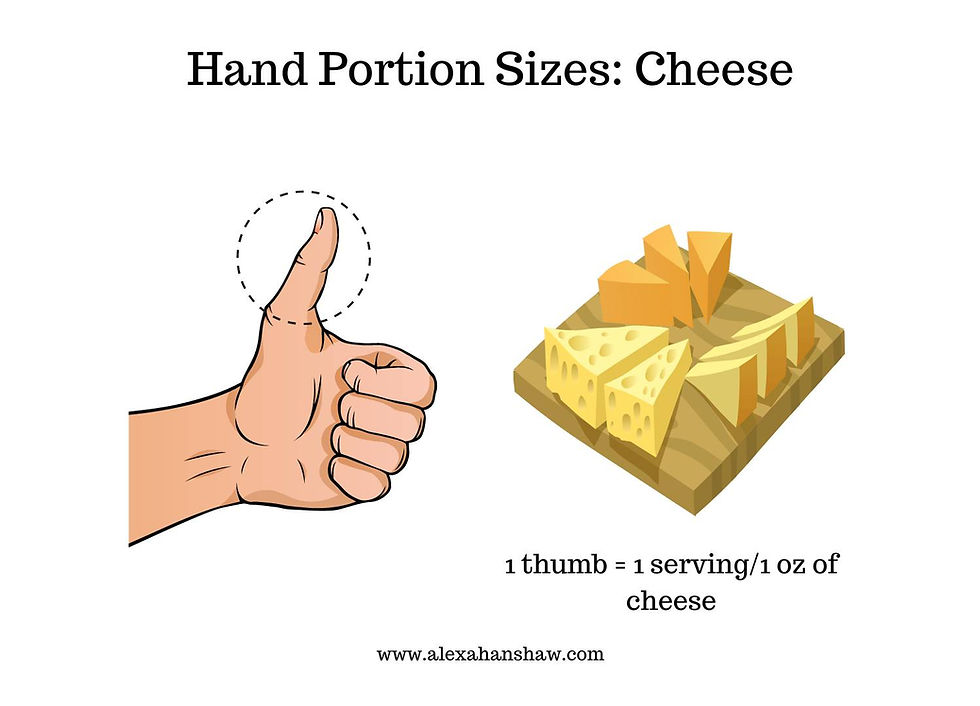Are you trying to eat healthy and in doing so keeping track of your portion sizes?
Have you spent countless hours, cumulatively, getting the right portions of your food? Do you weigh every bit of food you put on your plate or using measuring cups or spoons?
If so, then this blog is for you! In this blog post, I will share insights on portioning your foods using your hands as a functional health and nutrition coach.

Portioning your food is an important part of managing your weight and health. A good way to do this is by using your hand as a guide for how much you should eat at each meal. This can help you better understand what appropriate portion sizes look like.
Instead of using scales or measuring cups to determine how much food you should eat. Try to use your hand as a visual reference for an appropriate portion.
This way, you'll save more time and energy, which you should spend enjoying your meal. After all, your hands are always with you.
Keep reading to learn more about hand portion sizes.
Table of Contents:
Hand Portion Sizes: Estimating Portion Sizes With Your Hand
Berries
Berries are an excellent source of fiber, vitamins (such as vitamin C), and minerals. They're also versatile ingredients that you can add to your desserts, smoothies, and salads.
According to the Harvard School of Public Health [1], people who eat a lot of berries seem to have longer lives and a lower risk of cancer. Eating blueberries can reduce your risk of getting Type 2 diabetes. Also, foods high in anthocyanins, such as blueberries and strawberries, can help with weight loss.
So, how do you portion berries using your hands?
Use both of your hands to form a cup, and cover the center of both palms with berries. This equals one serving of berries in your meal.

Leafy Greens
Adding leafy greens to your diet can be a great way to get more vitamins, minerals, and fiber. Leafy greens are low in calories but help fill you up with all the fiber they provide, so you will not only feel fuller longer but you are also getting a lot of nutrients.
Leafy greens can also support your gut, immune system, and bone health, relieve stress, and protect your brain.
In order to get the most out of your leafy greens, try to eat a variety. Some options include kale, spinach, chard, broccoli, collards, and arugula.
So, how do you portion leafy greens using your hands?
Use both hands and cup a heaping handful of leafy greens. This is equal to one serving of leafy greens in your meal. You can add more if you want since they have low-calorie content and are full of nutrients.

Proteins
Having proteins in your diet is important, especially if you are trying to build lean muscle mass, recover from injuries, or keep a healthy weight. You can get protein from meat, fish, poultry and plant based sources.
If you are trying to cut down on your meat consumption and want to try something different, then opt for one of the below plant-based options.
Here are some plant-based sources of protein:
Tofu
Edamame
Lentils
Chickpeas
Peanuts
Quinoa
Chia Seeds
Seitan
Almonds
So, how do you portion proteins using your hands?
One serving of meat is equal to the size of your palm in one hand and about the thickness of a deck of cards. This is equal to about 3-4 ounces of protein.

Carbohydrates
Carbohydrates are an essential part of your diet, but they can also be one of the biggest sources of calories. You need carbohydrates to provide energy for your body, especially during exercise.
Healthy sources of carbohydrates include whole grains, fruits, and vegetables. The more refined your carbs are, such as white bread or pasta, the less nutrients they likely contain.
When it comes to choosing carbs, stick with low/unprocessed sources like whole grains and fresh produce instead of processed foods.
So, how do you portion carbohydrates (like rice & pasta) using your hands?
Form a fist using your hands — this is equal to one serving or 1/2 cup of pasta or rice.

Fats
Fats are an essential part of your diet and they can provide a lot of calories. You need fats to help absorb certain vitamins and nutrients and keep your skin healthy but not all fat is creating equally.
Most of the time, you should choose unsaturated fats over saturated ones. Unsaturated fat comes from plants like nuts and seeds or fish like salmon, while saturated fat is found in red
meat, poultry skin, butter, lard (pig fat), and coconut oil.
So, how do you portion fats using your hands?
The tip of your thumb is equal to one serving or one tablespoon of fat.

Cheese
If you love cheese, it’s important to portion it carefully. Cheeses are a good source of calcium, protein, vitamins and they also contain saturated fat.
So, how do you portion cheese using your hands?
The size of your entire is equivalent to one serving or 1 ounce of cheese.

What to do next?
It’s important to know how much food you should eat to stay healthy, but it can be difficult when you don’t have a standard portion size. To help with this, I created a list of hand portion sizes for common foods.
This will make it easier for you to keep in mind when eating out or preparing meals at home. I hope this list helps you become more aware of your food choices and portions. The more you know the better decisions you can make for yourself and your family.
If you learned something from this list, please share it with others. If you have any questions or comments about the post, feel free to leave them below.

About the Author
Alexa Hanshaw
Co-Author: Irish Doton
Alexa Hanshaw is a health and stress management coach who helps women be the CEO of their stress. She empowers her clients to push past the confusion of the health and wellness industry to create lifestyle habits that bring them energy and work with their bodies instead of against it.
Join her free Facebook group, Be the CEO of Your Stress and follow her on Instagram, Facebook, and Youtube for quick, easy & healthy tips on stress, health, fitness, nutrition, sleep, and how to stay mindful!


Commentaires